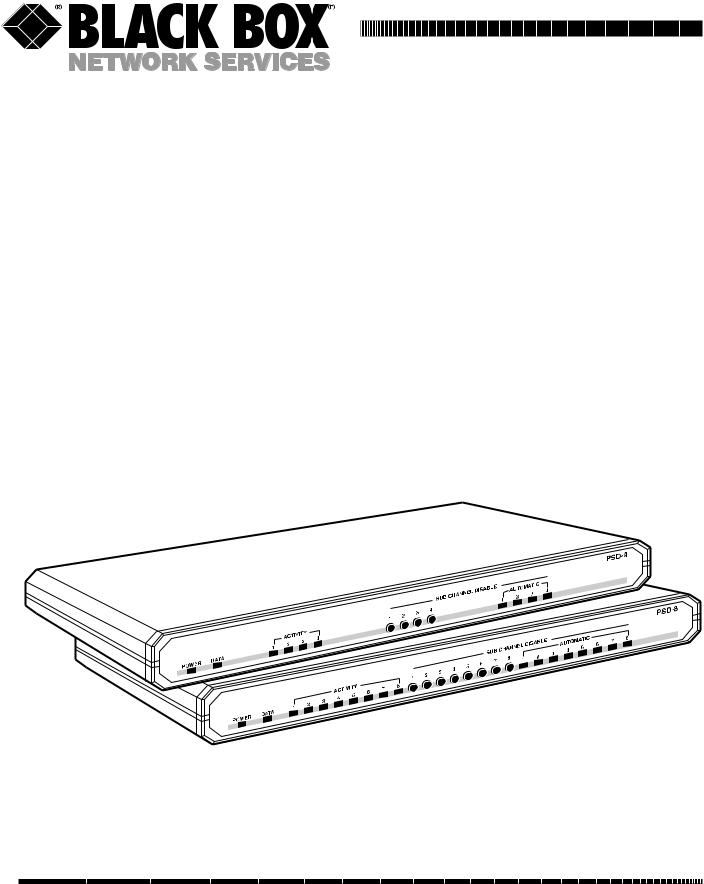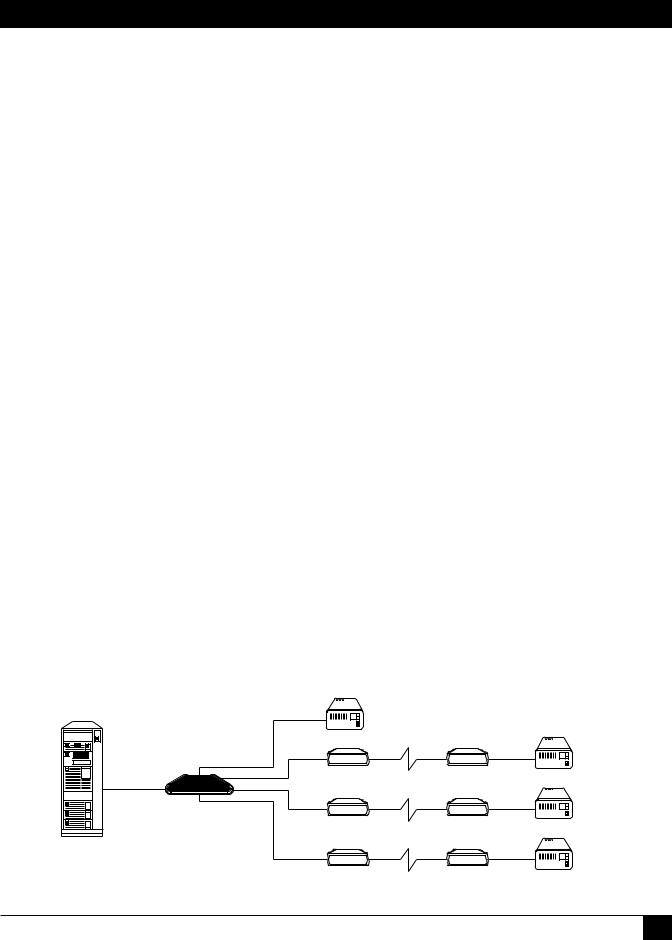Black Box PSD-8, PSD-4 User Manual

SEPTEMBER 1998
TL304A
TL305A
PSD-4
PSD-8
CUSTOMER |
Order toll-free in the U.S.: Call 877-877-BBOX (outside U.S. call 724-746-5500) |
|
SUPPORT |
FREE technical support 24 hours a day, 7 days a week: Call 724-746-5500 or fax 724-746-0746 |
|
INFORMATION |
Mailing address: Black Box Corporation, 1000 Park Drive, Lawrence, PA 15055-1018 |
|
Web site: www.blackbox.com • E-mail: info@blackbox.com |
||
|

FCC STATEMENT
FEDERAL COMMUNICATIONS COMMISSION
AND
INDUSTRY CANADA
RADIO FREQUENCY INTERFERENCE STATEMENTS
This equipment generates, uses, and can radiate radio-frequency energy, and if not installed and used properly, that is, in strict accordance with the manufacturer’s instructions, may cause interference to radio communication. It has been tested and found to comply with the limits for a Class A computing device in accordance with the specifications in Subpart B of Part 15 of FCC rules, which are designed to provide reasonable protection against such interference when the equipment is operated in a commercial environment. Operation of this equipment in a residential area is likely to cause interference, in which case the user at his own expense will be required to take whatever measures may be necessary to correct the interference.
Changes or modifications not expressly approved by the party responsible for compliance could void the user’s authority to operate the equipment.
This digital apparatus does not exceed the Class A limits for radio noise emission from digital apparatus set out in the Radio Interference Regulation of Industry Canada.
Le présent appareil numérique n’émet pas de bruits radioélectriques dépassant les limites applicables aux appareils numériques de la classe A prescrites dans le Règlement sur le brouillage radioélectrique publié par Industrie Canada.
1

PSD-4 AND PSD-8
INSTRUCCIONES DE SEGURIDAD (Normas Oficiales Mexicanas Electrical Safety Statement)
1.Todas las instrucciones de seguridad y operación deberán ser leídas antes de que el aparato eléctrico sea operado.
2.Las instrucciones de seguridad y operación deberán ser guardadas para referencia futura.
3.Todas las advertencias en el aparato eléctrico y en sus instrucciones de operación deben ser respetadas.
4.Todas las instrucciones de operación y uso deben ser seguidas.
5.El aparato eléctrico no deberá ser usado cerca del agua—por ejemplo, cerca de la tina de baño, lavabo, sótano mojado o cerca de una alberca, etc..
6.El aparato eléctrico debe ser usado únicamente con carritos o pedestales que sean recomendados por el fabricante.
7.El aparato eléctrico debe ser montado a la pared o al techo sólo como sea recomendado por el fabricante.
8.Servicio—El usuario no debe intentar dar servicio al equipo eléctrico más allá a lo descrito en las instrucciones de operación. Todo otro servicio deberá ser referido a personal de servicio calificado.
9.El aparato eléctrico debe ser situado de tal manera que su posición no interfiera su uso. La colocación del aparato eléctrico sobre una cama, sofá, alfombra o superficie similar puede bloquea la ventilación, no se debe colocar en libreros o gabinetes que impidan el flujo de aire por los orificios de ventilación.
10.El equipo eléctrico deber ser situado fuera del alcance de fuentes de calor como radiadores, registros de calor, estufas u otros aparatos (incluyendo amplificadores) que producen calor.
11.El aparato eléctrico deberá ser connectado a una fuente de poder sólo del tipo descrito en el instructivo de operación, o como se indique en el aparato.
12.Precaución debe ser tomada de tal manera que la tierra fisica y la polarización del equipo no sea eliminada.
13.Los cables de la fuente de poder deben ser guiados de tal manera que no sean pisados ni pellizcados por objetos colocados sobre o contra ellos, poniendo particular atención a los contactos y receptáculos donde salen del aparato.
14.El equipo eléctrico debe ser limpiado únicamente de acuerdo a las recomendaciones del fabricante.
15.En caso de existir, una antena externa deberá ser localizada lejos de las lineas de energia.
16.El cable de corriente deberá ser desconectado del cuando el equipo no sea usado por un largo periodo de tiempo.
17.Cuidado debe ser tomado de tal manera que objectos liquidos no sean derramados sobre la cubierta u orificios de ventilación.
18.Servicio por personal calificado deberá ser provisto cuando:
A:El cable de poder o el contacto ha sido dañado; u
B:Objectos han caído o líquido ha sido derramado dentro del aparato; o
C:El aparato ha sido expuesto a la lluvia; o
D:El aparato parece no operar normalmente o muestra un cambio en su desempeño; o
E:El aparato ha sido tirado o su cubierta ha sido dañada.
2

TRADEMARKS
TRADEMARKS USED IN THIS MANUAL
AS/400 is a registered trademark of International Business Machines Corporation.
Any other trademarks mentioned in this manual are acknowledged to be the property of the trademark owners.
3

PSD-4 AND PSD-8
1. Specifications
Number of Sub-Channels — |
|
PSD-4: |
4 |
PSD-8: |
8 |
Channel Configuration — |
|
Lowest Priority: |
Sub-channel 1 |
Highest Priority: |
PSD-4: Sub-channel 4 |
|
PSD-8: Sub-channel 8 |
Sub-Channel Selection — RTS/DCD on or data transitions (strap-selectable)
Sub-Channel Deselection — RTS/DCD off or 16 bits of idle data (strap-selectable)
Sub-Channel Dialing —
Manual: Press in the front-panel pushbutton switch
Automatic: If a sub-channel stays connected for more than a pre-set period of time (strap-selectable—1.7, 13.5, or 108), the PSD automatically disables it
Clock Source — Internal, external from main channel, or external from sub-channel 1
Data Rates —
Asynchronous: Up to 19.2 kbps
Synchronous: Internal Clock: 1.2, 2.4, 4.8, 7.2, 9.6, 14.4, or 19.2 kbps External Clock: Up to 19.2 kbps
Connectors — IEIA RS-232-C/CCITT V.24; DCE or DTE (strap-selectable)
Controls — Front-panel SUB-CHANNEL DISABLE pushbutton switch for each sub-channel; rear-panel POWER rocker switch; rear-panel 110/220 VAC selector
LED Indicators — POWER: |
Lights when the unit is receiving AC power |
DATA: |
Lights when data is broadcast from the main channel |
|
to the sub-channels |
ACTIVITY: |
Lights when the sub-channel accesses the main channel |
AUTOMATIC: |
Lights when sub-channel has been automatically disabled |
Temperature — 32 to 122°F (0 to 50°C)
Humidity — 30 to 90%, non-condensing
Power — 110/220 VAC switchable + 10%
Size — I1.7"H x 17"W x 8.2"D (4.3 x 43.1 x 20.8 cm)
Weight — 4.4 lb (2.0 kg)
4

CHAPTER 2: Introduction
2. Introduction
The Programmable Sharing Device enables up to 4 (TL304A) or 8 (TL305A) modems or terminals to share
a master modem, multiplexor, or computer port in an asynchronous or synchronous multipoint environment. (Asynchronous and synchronous equipment cannot be mixed on the same PSD.)
MAIN CHANNEL
The main channel transmits information to all sub-channels in parallel.
SUB-CHANNELS
Sub-channels contend to transmit to the main channel by activating RTS/DCD (Request to Send/Data Carrier Detect) or by data transitions (strap-selectable). When the sub-channel is active, the sub-channel’s transmit data and control signals are connected to the main channel. When RTS/DCD drops, data transitions stop, or 16 idle bits are received, the PSD will disconnect and monitor other sub-channels.
Sub-channels can be disabled either manually by front-panel pushbuttons or automatically. If a sub-channel
is streaming and staying active for longer than a configured amount of time, the PSD will automatically disable that sub-channel. A front-panel LED will illuminate to indicate that the sub-channel has been automatically disabled. The sub-channel will be reset when RTS/DCD drops or 16 idle bits are transmitted to it from the attached device.
CLOCK MODES
Three clock modes are supported: internal, external from the main channel, or external from sub-channel 1.
BUFFER
A built-in-buffer compensates for phase differences between the clocks of modems connected to the subchannels and the PSD main-channel transmit clock.
An extra-buffer option on the PSD-8 can be activated when the PSD is connected to equipment that cannot accept an external clock. Examples include DDs (United States) or other digital lines and modems that cannot be set to an external clock. This additional buffer compensates for phase differences between the PSD clock and sub-channel clock(s).
RS-232 Cable |
|
RS-232 Cable |
Controllers |
Modem |
Modem |
|
Dialup Line |
PSD-4 |
|
Modem |
Modem |
|
Leased Line |
AS/400® |
|
CSU/DSU |
CSU/DSU |
|
Leased Line |
Figure 1. The Programmable Sharing Device allows multiple devices to share a master port.
5
